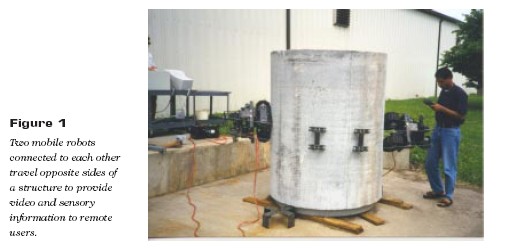The project investigated the feasibility of using a semiautonomous robotic system to position a sensor platform in close proximity to underwater bridge support structures while providing video or other sensory information to support evaluation and documentation of structural condition, including scour. The primary system consists of two or more identical mobile robots designed to travel along opposite surfaces of submerged structures while connected to one another by a cable and winch system (Figure 1). Each robot contacts the surface through cleated rubber tracks (or, alternatively, wheels and rubber tires) that are driven by internal motors. Tensioning the cables that connect the two robots provides traction. In response to an operator’s command to move to a new position, the robot team automatically coordinates both movement and cable tension. A graphical user interface provides the operator status information and control options. This robotic system may be used to augment traditional diver inspections, thereby reducing diver time and cost and enhancing safety.
Two prototype systems were constructed and tested, and the findings applied to development of a third system of significantly different design. This system has a broad array of potential applications for inspection of submerged physical structures, such as bridge substructures, pipelines, water towers, industrial smokestacks, nuclear cooling towers, oil rigs, oil derricks, floating platform support structures, and docks.
The Kansas State University Research Foundation is pursuing patent protection for all aspects of this system. The Mid-America Commercialization Corporation is developing commercialization strategy for this technology. Initial estimates of the manufactured costs of the system range from $25,000 to $50,000. The final report is available from the National Technical Information Service (NTIS # PB99-130700).

The final report for this IDEA project can be found at:
https://onlinepubs.trb.org/onlinepubs/archive/studies/idea/finalreports/highway/NCHRP043_Final_Report.pdf